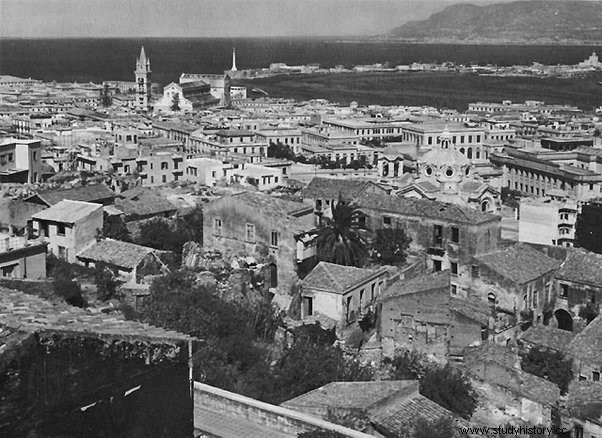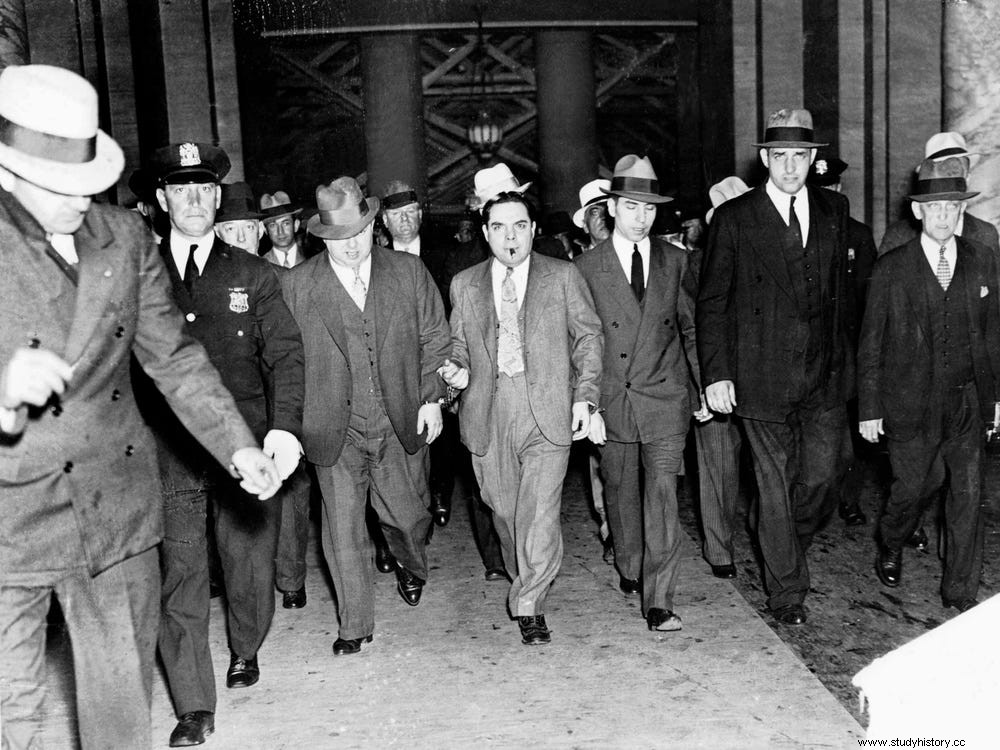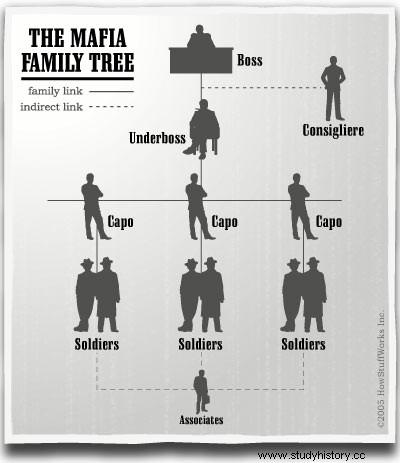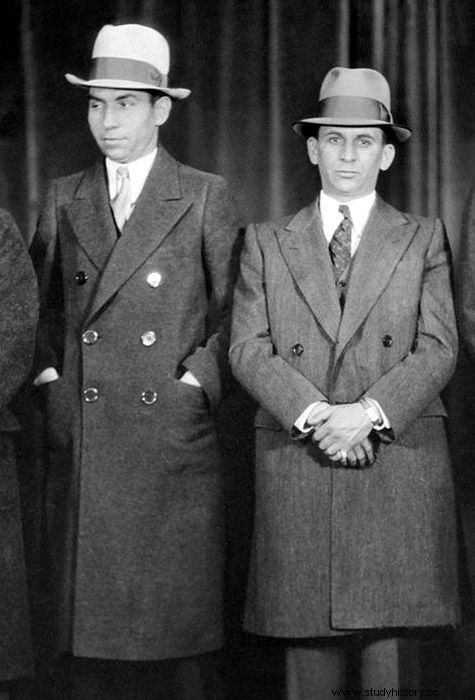The Mafia drove the creativity of movies, TV series and novels with their history, commandments, traditions and leaders.
Everyone is familiar with the fame of the mafia, their history and intricately portrayed ways. From Italy to America, their codes and ethics survive today just like the stories of legendary mafia.
Mafia Terminology

Cosa Nostra
Cosa Nostra translated to "our thing" or "this our thing".
Originally, the term referred to the general lifestyle of Sicilian organized criminals.
When the mafia moved to the United States (USA), the FBI listened to their conversations through wiretapping. One term they picked up was 'La Cosa Nostra'.
As a result Cosa Nostra referred to the Mafia at the time, although it is grammatically incorrect.
Now it refers specifically to American members of the mafia. This sets them apart from "Old World" mobsters.
Omertà
Omertà is a code of confidentiality, especially when disclosing information to law enforcement.
The rule, when broken, results in death.
Family
Every single gang in the mafia is called a 'family'. However, not everyone is related, but it is common for male members to be in the same family as their fathers or brothers.
Made men
These are men officially incorporated into a mafia family.
Wiseguy
A wise man is one who is involved in the mafia.
Etymology of 'mafia'
The exact origin of the 'Mafia' is still unknown.
It may refer to a Sicilian noun, mafiusu (mafioso), which translates to swagger (a very confident and arrogant or self-important way).
Some say it refers to a man of 19 th century in Sicily, although this seems vague. It means a bully, arrogant, but fearless, resourceful and proud.
The feminine form, mafiusa , means beautiful or attractive woman.
Mafie could refer to the caves near Trapani and Mansala, which were often the refuge of refugees and criminals.
In addition, Sicily was once an Islamic emirate.
The term may be a Sicilian-Arabic slang term, meaning "act as a protector against the arrogance of the powerful".
Selwyn Raab, author of Five Families:The Rise, Decline and Resurgence of America's Most Powerful Mafia Empires , noted that up to 19 th century, mafioso did not refer to a person involved in criminal activity. It referred to a person who was suspicious of central government.
The origin of the mafia

For centuries, foreign invaders ruled Sicily. Such invaders included the Phoenicians, the Romans, the Arabs, the French and the Spanish.
The Sicilian people formed small groups to protect themselves from foreign forces, along with regional groups of Sicilians.
These groups later became known as 'clans' or 'families'. They created their own system of justice and retribution, their actions performed in secret.
I 19 th century, formed small private armies called the 'mafia'. They took advantage of the chaotic conditions in Sicily. For example, they extort protection money from landowners.
From this emerged the Sicilian mafia, a collection of criminal families.
The Rise of the Mafia in Italy
In 1861, Sicily became a unified province of Italy. When the Italian government tried to establish itself, crime and chaos reigned all over the island.
In the 1870s, Roman officials asked the clans [Sicilian mafia] for help in pursuing the dangerous, independent criminals. In return, officials saw the other way as the mafia continued its blackmailed protectionist services against landowners.
However, the government believed that this was a temporary solution. The Sicilian Mafia expanded its criminal activities and became further involved in Sicilian politics and its economy.
Therefore, the mafia became involved and known for political corruption, and scared people to vote for certain candidates. The elected candidates will in turn owe the mafia a favor.
In addition, there were cases where the Catholic Church became involved in the mafia. The Mafia monitored the Church's property holdings and kept tenants in line.
The Mafia of America

Between the end of 19 th century and early 20 th century, the Italians came to America for better economic opportunities. The majority of Italian immigrants were farmers, artisans and unskilled workers.
In New York City (NYC), between 1880 and 1890, there were 20,000 250,000 to 1910,500 Italian immigrants. In 000 there were XNUMX XNUMX Italian immigrants and first generation Italian Americans.
Although the majority of immigrants were law-abiding, some went the criminal route. They formed neighborhood gangs that often plundered their own communities.
Prohibition period
During the 1920s ban, Italian-American gangs, along with other ethnic gangs, entered the large liquor industry. As a result, they developed into a sophisticated criminal business.
In addition, they became skilled at smuggling, laundering money and bribing police and other government officials.
At this point, the fascist regime of Benito Mussolini attacked the Sicilian mafia. They threatened and undermined Mussolini's power in Sicily.
Some Sicilian mafiosi fled to the United States. They became part of the thriving American mafia and became involved in bootlegging.
The American Mafia and the Sicilian Mafia are different entities. However, the American mafia adopted some Sicilian traditions, such as omertà.
Operation Underworld
From 1942 to 1945, the Italian and Jewish organized crime figures collaborated with the US Navy.
The temporary alliance took place after a fire consumed SS Normandy. The former luxury French liner became an American World War II (XNUMX. World War) troop transport.
Many feared it was Nazi saboteurs, while others saw it as an accident.
Despite the theories, the US government took action.
With the mafia, they also recruited Fulton Fish Market king Joseph 'Socks' Lanza. Lanza was a member of the Genovese family. He gave undercover agents union cards, which allowed them to enter the market and aboard coastal fishing fleets.
As for the mafia, they opposed counter-spies and saboteurs along the ports off the northeast coast of the United States, prevented trade union strikes in wartime and restricted the theft of black exchanges.
Castellamarese Wars
The Castellamarese War was a violent feud between two of NYC's largest Italian-American gangs, controlled by Joseph 'Joe the Boss' Masseria and Salvatore Maranzano.
The war began when Masserina tried to gain control of organized crime in the United States
It ended in 1931 when Maranzo conspired with Massaria's top soldier, Charles 'Lucky' Luciano, to have Masseria killed. In return, Maranzno Luciano promised that all gangsters would be equal.
Maranzano emerged victorious and was the most powerful mafia boss in the nation. He called himself capo dei capi or capo di tutti i capi , 'bosses for bosses'. This is better known as the Godfather.
Therefore, Maranzano was the first leader of the Cosa Nostra .
He established its ethical guidelines, divisions and structure for the five families and developed dispute resolution procedures.
But when he took the title "boss of bosses", he broke the agreement with Luciano.
Under Luciano's order, 10 men murdered Maranzano on September 10, 1931.
As a result, the Commission eliminated the "boss of all bosses" position.
The Mafia's Five Families

The original Five Families name was after the founders, their very first leaders.
- Salvatore Maranzano - The Maranzano Family.
- Giuseppe 'Joe' Profaci - The Profaci Family.
- Vincent Mangano or 'Vincent the Executioner' - The Mangan Family.
- Charles 'Lucky' Luciano - The Luciano Family.
- Thomas 'Tommy' Gagliano - The Gagliano Family.
In 1963, Joseph Valachi publicly revealed the existence of the five families during 'Valachi hearings'.
Then the original names of the five families were changed to the names of the bosses at that time.
- Joseph 'Joe Bananas' Charles Bonanno - The Bonanno Family.
- Joseph Anthony Colombo - The Colombo Family.
- Carlo Gambino - The Gambino Family.
- Vito Genovese - The Genovese Family.
- Thomas 'Tommy' Gaetano Lucchese or 'Thomas Luckese', 'Tommy Brown' or 'Tommy Three-Finger Brown' - The Lucchese Family.
The names often remain used when referring to the five families, despite years of changing bosses in each.
The structure of Cosa Nostra

The Boss or Don
'Don' is the leader of every family.
He makes all the big decisions. The money that the family earns eventually goes to him.
In addition, he uses his authority to resolve disputes and keep everyone in line.
Subject
Although second-in-command, the power exercised by the deputy commander varies.
Some resolve disputes without involving the boss.
Others are asked to replace the boss if he is too old or in danger of going to jail.
Capos
Originally, the capo was the head of the family.
Currently, a capo works as a lieutenant, leading his own part of the family.
The number of capos varies depending on the size of the family.
They run specific activities and their territory can be defined geographically or by the rackets they run.
To be a successful capo, the key is to make money. He keeps some money earned with his rackets and gives the rest to the deputy boss or boss.
Mafia soldiers
Soldiers are the lowest rank of the family that does the dirty work.
They have little power and make little money.
The number of soldiers under a capo varies greatly.
Employees of the mafia
The affiliates are not actual members of Cosa Nostra , but they work with soldiers and capos in their criminal activities.
Employees vary by profession, from burglars and drug dealers to lawyers, investment bankers, police officers and politicians.
Advisor
Counselors are not meant to be part of the family.
He acts as an advisor and makes impartial decisions based on justice and logic instead of emotions or vendettas.
Family members should choose the counselor, not the boss.
In reality, they can be appointed by the boss and their decision-making is not always impartial.
Commission
The commission consists of the leader of each of the five families, along with the leaders of the Buffalo crime family and the Chicago Outfit.
As the governing body of the American mafia, they settle all disputes.
They delimit territory between former warring factions and control all activities in the United States and Canada.
Introduction to the Mafia

Until Joe Valachi's testimony, the mafia inauguration ceremony was a secret kept for decades.
However, certain circumstances change the details of the induction ceremony. For example, induction in a prison or quick introduction during a gang war.
First, the potential soldier is asked to 'dress up' or 'get dressed'.
The mobsters take him to a private place, where they sit at a table next to the boss. They all go and recite you and promise loyalty.
The inmate then holds a piece of burning paper. He has to endure the pain and the heat, sending the paper from hand to hand until it is completely used up.
In doing so, they swear to keep the faith and uphold the principles of the mafia.
Finally, they must promise to be a member of the family for life. Then a drop of blood is drawn from his trigger finger.
Some families pair the introduced with a very experienced and ranked mafioso, to guide them into life.
Induction Rules
The Mafia only allows men with Italian heritage to join.
In some families, both parents must be Italian or of Italian heritage.
In others, they only require that the father is Italian or of Italian heritage.
Prisoners must show skills to make money or show willingness, when ordered, to commit acts of violence.
In addition, they must pass a test before they are invited to join, to "make their bones". They must commit murder on one of Don's enemies.
But just being invited by a Don is not how you get hired. They must also be considered by the Commission.
In the 1920s and 1930s, during the raging gang wars, families recruited a large number of new soldiers.
New soldiers became unknown to other families. They easily approached rival kapos and made men and murdered them. The Commission managed to prevent this.
The families now give the commission a list of potential inmates. The commission then circulates the list among the families.
This eliminates the risk of not being recognized. In addition, it provides the opportunity to remove any inmate another family has a problem with.
Therefore, it averts all violence and, above all, a war among families.
Women in the Mafia
The primary image of a gangster is a man.
The Mafia sends women to be wives, mothers or even low-level criminals.
But in recent years this has changed.
During police attacks on the mafia in the 1980s, male gangsters handed over their belongings to their wives and daughters before going to prison. From then on, women took on criminal activities until their husbands and / or fathers were released.
Like their male gangsters, their female counterparts were just as ruthless, strategic and daring.
A good example is Connie Rastelli, wife of Philip 'Rusty' Rastelli, the former head of the Bonanno family.
She helped her husband a lot with his rackets.
She was allegedly a refugee driver, ran illegal abortion centers, collected loans, threatened witnesses and may have been involved in murder.
Remarkable members of the mafia

Benjamin 'Bugsy' Siegal
Siegal was a well-known mafia hitman and enforcer, who ended up controlling his own rackets.
He also co-founded Murder Inc., the bullying enforcement arm.
In 1936 he became well acquainted with Meyer Lansky, 'Mobben's Accountant'.
He then moved to California and developed rackets for the mob bosses. His good looks and charm were favored by Hollywood celebrities. He soon gained his own fame.
Together with his girlfriend, he developed casinos in Las Vegas, Nevada. He put out mob funds that were for construction costs.
Lansky and other East Coast chiefs ordered a hit job on Siegal for his disloyal activities.
In 1947, at the age of 41, the assassins beat him with a flood of bullets outside his girlfriend's home.
Charles 'Lucky' Luciano
A Sicilian raised in New York, Luciano was instrumental in the creation of the National Crime Syndicate.
He was considered the mastermind of modern organized crime since its inception.
When he became head of the Genovese family, he was one of the most powerful mob leaders.
Attorney General Thomas E. Dewey locked Luciano in for his prostitution business in 1936.
Finally, Luciano shortened his sentence to 30 years when he helped the US Navy during World War II.
In 1946 he was deported to Italy and managed to conduct his drug operations in the United States from there.
He died in 1962 of a heart attack at an airport in Naples.
Frank Costello
Italian born and raised in East Harlem, Costello became acquainted with Luciano.
After that, he became involved in gambling and bootlegging and construction in New York and the South.
Locally, he gained broad political influence and became the chief syndicate chief after Luciano went to prison.
During the 1950s, he was in and out of prison for contempt and tax evasion.
In 1957, he was briefly in the head, under orders from rival bullying boss Genovese.
Costello miraculously survived and continued the operations, although his power was reduced.
He died at the age of 82 of a heart attack.
Samuel 'Sam' Mooney Giancana
Giancana is legendary in mob history.
In the underworld, he is known for his ruthless personality. Rumor has it that he committed at least three murders when he was 20 years old and was arrested over 70 times.
He led the Chicago Outfit from 1957 to 1966 and was obsessed with American politics.
Giancana is also known for his ties to Joseph P. Kennedy. He asked Giancana to help secure votes for his son, John F. Kennedy, in the 1960 election.
Shortly afterwards, reports say that Giancana was furious at JFK for giving Attorney General Robert E. Kennedy approval to prosecute organized crime.
Moreover, this led to a conspiracy theory that the JFK assassination was a hit job of the mob, orchestrated by Giancana.
Conclusion about the mafia

From Italy and America, the mafia maintains its traditions and activities. Some avoid arrest and some do not, but in any case their morals and traditions live on through the next generation.
The strength of a family, like the strength of an army, lies in its loyalty to one another.
-Mario Puza, author of The Godfather.
